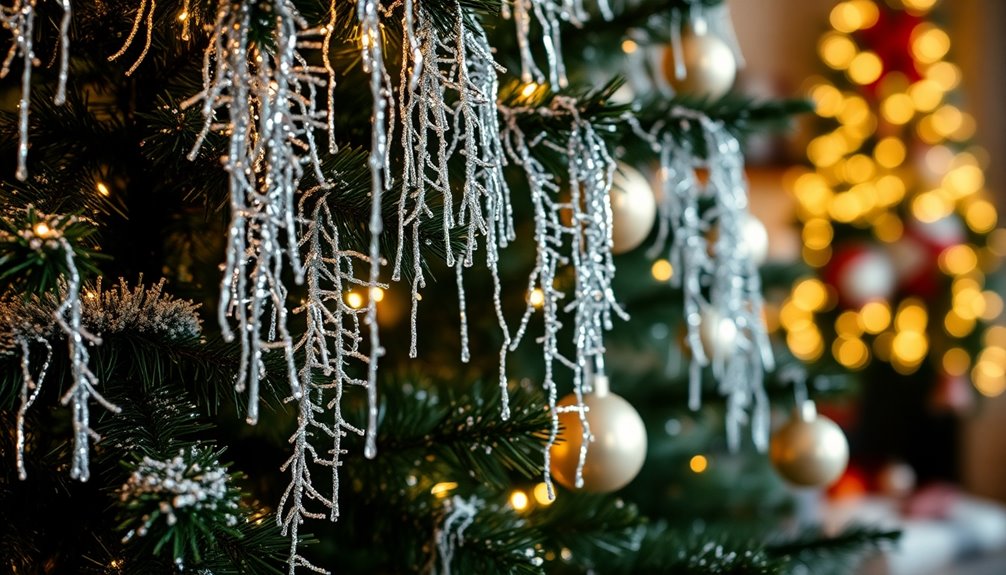Tinsel on your Christmas tree symbolizes joy and celebration, tracing its origins back to the 1600s. Initially made from real silver, it signified luxury and festivity. Over the years, tinsel evolved from metal to lead and finally to the modern PVC plastic we use today. This shiny decoration gained popularity in the Victorian era, enhancing the holiday atmosphere. While tinsel adds sparkle, it's important to reflect on its environmental impact. Luckily, there are eco-friendly alternatives now available. If you're curious about how this tradition has transformed through the years, there's plenty more to explore!
Key Takeaways
- Tinsel originated in the 1600s, initially made from silver, symbolizing luxury and enhancing the beauty of Christmas trees.
- Associated with Victorian traditions, tinsel gained popularity after being featured in an 1842 family photo of Queen Victoria.
- Tinsel represents joy and celebration during the holiday season, evoking nostalgia and connections to historical decorating practices.
- Modern tinsel is primarily made from PVC plastic, reflecting consumer preferences while raising concerns about environmental impact.
- Eco-friendly alternatives are emerging, promoting sustainable decorating options and reducing plastic pollution during the holidays.
Historical Origins of Tinsel
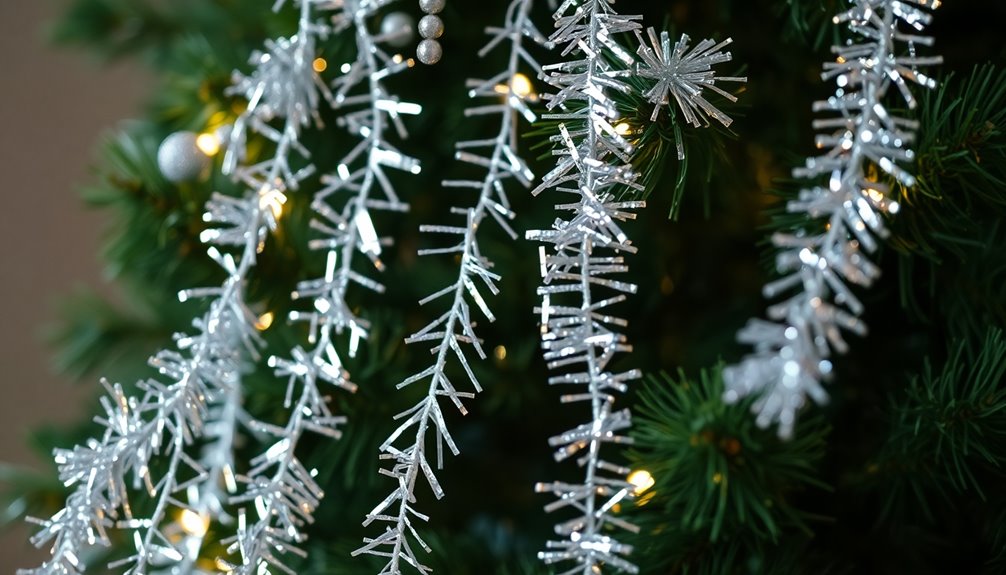
Tinsel has a fascinating history that dates back to the 1600s when it first adorned Christmas trees. The word "tinsel" comes from the Old French "estincele," meaning spark.
Initially, tinsel was made from actual silver, expertly beaten into thin strips to catch the flicker of candlelight. This luxurious decoration symbolized opulence, primarily found in affluent households.
However, as silver became costly and tarnished over time, alternatives emerged. By the early 20th century, lead-based tinsel gained popularity as a more affordable option, despite its eventual health risks.
Understanding the historical origins of tinsel enriches your appreciation for this sparkly tradition, showcasing how it transformed from a luxury item to a beloved holiday decoration on the Christmas tree.
Tinsel in Christmas Traditions
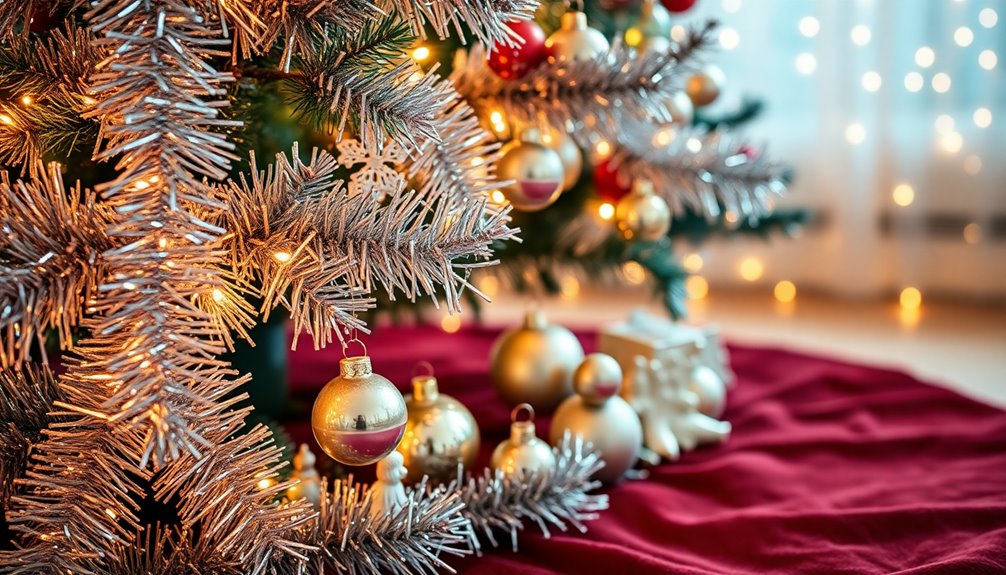
When you think about tinsel, it's hard not to recall its rich history in Christmas traditions.
From its royal beginnings in Queen Victoria's family photo to its role in creating a sparkling ambiance on your tree, tinsel has a unique symbolism that enhances the festive spirit.
Let's explore how this enchanting decoration has shaped holiday customs over the years.
Historical Usage of Tinsel
Since its introduction in the 1600s, tinsel has played a significant role in Christmas traditions, enhancing the enchanting glow of candlelight on decorated trees.
Initially, tinsel fabrics were made from real silver, adding a luxurious touch to holiday decor. By the early 20th century, lead foil became a more affordable alternative, though health concerns later led to its decline.
The 19th century saw a surge in tinsel's popularity, especially after media showcased Queen Victoria's family with beautifully adorned Christmas trees in 1842.
By the 1920s, tinsel had become a staple, often mimicking icicles and complementing electric lights.
Today, you can find a variety of modern tinsel, keeping its festive spirit alive during the holiday season.
Symbolism in Decorations
The shimmering strands of tinsel not only enhance the visual appeal of Christmas trees but also carry deep symbolism within holiday traditions.
During the holiday season, tinsel reflects the light from candles and electric lights, creating a festive atmosphere that embodies joy and celebration. Its roots trace back to the 19th century, becoming a staple in Christmas decorating after Queen Victoria showcased her beautifully adorned tree.
Originally made from real silver, tinsel mimicked ice, linking it to winter's beauty. Today, it's crafted from modern materials like PVC, yet it still represents festivity and grandeur.
The German term "Lametta" adds a touch of nostalgia, reminding us of tinsel's enduring role in our holiday celebrations.
Influence of Royalty
While tinsel might seem like a simple decoration today, its royal roots have profoundly shaped Christmas traditions. The popularity of tinsel skyrocketed after an 1842 photograph of Queen Victoria's family with a decorated Christmas tree adorned with this sparkly element.
Its reflective quality beautifully enhanced candlelight, creating a magical atmosphere around the tree. Initially crafted from real silver, tinsel symbolized affluence, echoing the grandeur of royalty.
Queen Victoria's embrace of the Christmas tree and tinsel marked a cultural shift, bringing festive decoration into British and American homes. This association with royalty has guaranteed tinsel's lasting presence in holiday celebrations, representing joy and festivity each Christmas season. Additionally, the rise of digital asset management has transformed how we preserve and display holiday traditions in modern times.
Evolution of Tinsel Materials
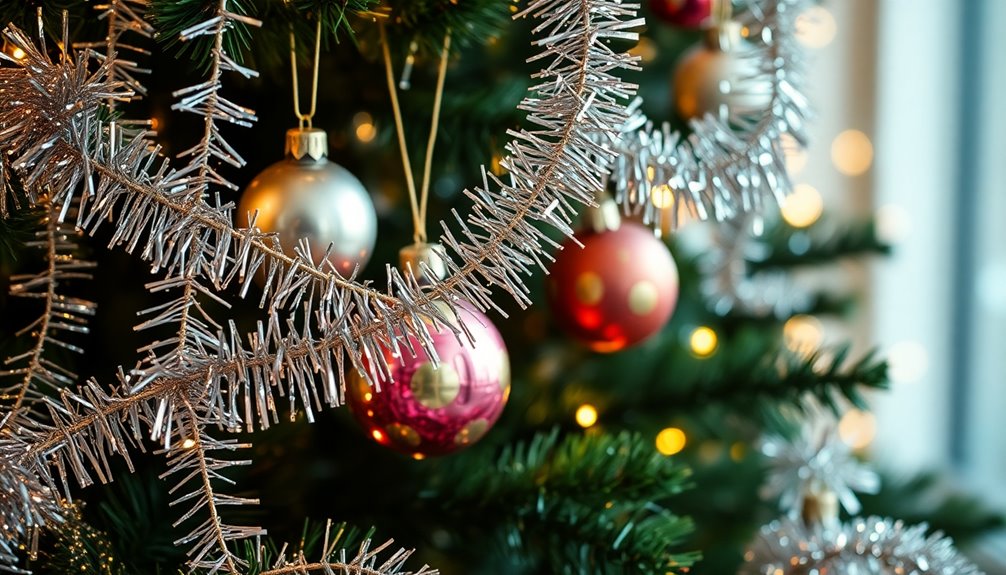
As tinsel evolved, so did the materials used to create it, reflecting changes in consumer preferences and safety standards.
Originally, tinsel was crafted from pure silver, hand-hammered into thin strips that beautifully reflected candlelight. However, the high cost and tarnishing issues made silver impractical for most.
In the early 20th century, shiny metals emerged as substitutes, with lead tinsel becoming a popular yet hazardous option due to health risks, particularly for children.
Today, modern tinsel is primarily made from PVC plastic, which is lightweight, safe, and comes in a rainbow of colors.
This shift from handmade luxury to mass-produced decorations highlights how consumer needs and safety regulations shape the evolution of tinsel materials over time.
Types of Tinsel Decorations
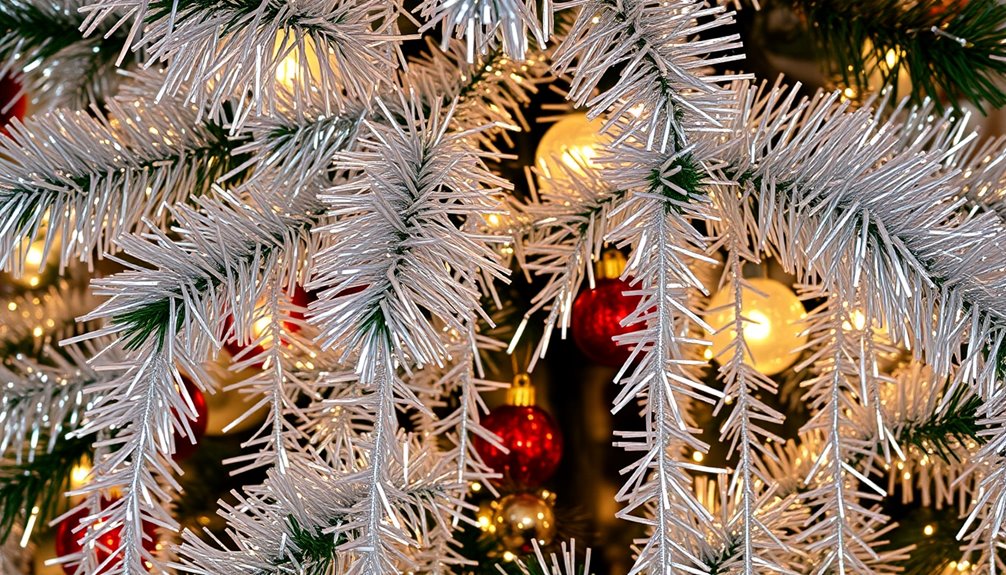
When decorating your tree, you'll notice various types of tinsel decorations available.
You can choose from traditional metal tinsel for a classic look, modern plastic variants in vibrant colors, or even eco-friendly alternatives that are better for the environment.
Each option adds its own charm and flair to your holiday setup.
Traditional Metal Tinsel
Traditional metal tinsel has long been a beloved decoration for Christmas trees, enchanting the eye with its shimmering allure. Originally crafted from real silver, hand-hammered into delicate strips, it created a magical effect. In the early 20th century, lead tinsel emerged as an affordable alternative, but health risks soon led to its decline. Today, you can still find variants like icicle tinsel and tinsel garland, both enhancing the beauty of commercial Christmas displays.
| Type of Tinsel | Description |
|---|---|
| Traditional Metal | Made from real silver or similar metals |
| Lead Tinsel | Affordable but phased out due to health risks |
| Icicle Tinsel | Resembles icicles, adding a wintery touch |
Modern Plastic Variants
Modern plastic tinsel has transformed holiday decorating, offering a lightweight, durable alternative to its metal predecessors. Made from PVC film, this modern plastic tinsel comes in a plethora of colors, including the classic silver thread and vibrant shades like blue and red.
You can easily decorate Christmas trees with various styles, such as icicle tinsel, which mimics the look of shimmering icicles, or thicker tinsel garland for draping on mantels and branches.
Unlike older versions, modern tinsel is non-toxic and complies with safety regulations, ensuring safer decorating practices.
Despite its evolution, this sparkling decoration remains a staple, maintaining the iconic shimmering appeal that makes your holiday season truly magical.
Eco-Friendly Alternatives
As awareness of the environmental impact of holiday decorations grows, many are turning to eco-friendly tinsel alternatives that not only look great but also reduce plastic waste.
You can find biodegradable options made from recycled paper or organic cotton, which break down more easily than traditional plastic tinsel. Some brands even offer tinsel made from sustainably sourced materials, minimizing environmental harm in both production and disposal.
Additionally, natural decorations like dried fruits, nuts, and popcorn garlands provide charming substitutes for conventional tinsel.
Innovations have led to plant-based tinsel that retains the festive sparkle while cutting down on plastic pollution. Furthermore, using natural remedies for stress relief like essential oils can enhance your holiday experience, making the season even more enjoyable.
Cultural Significance of Tinsel
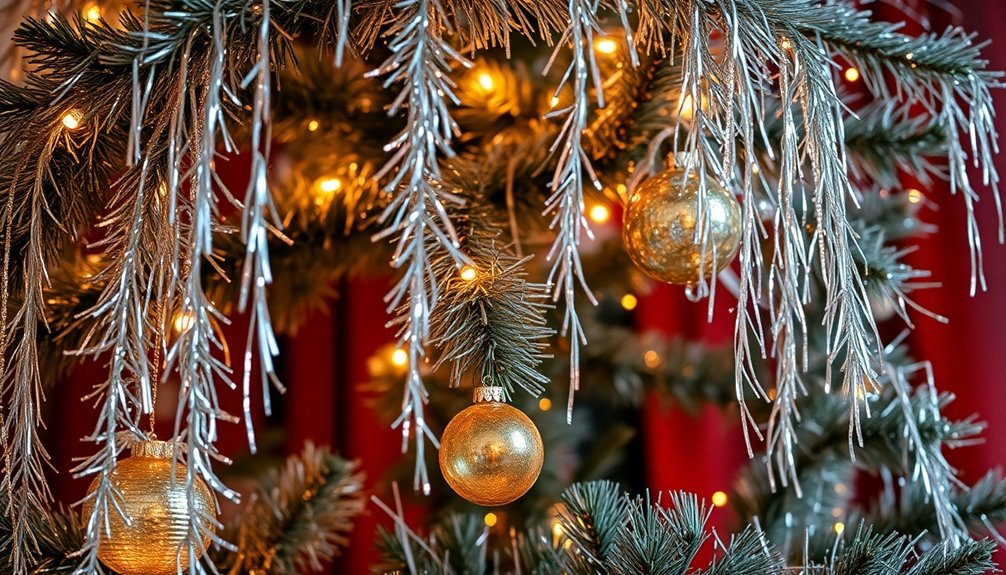
While tinsel may seem like a simple decoration, it carries deep cultural significance during the holiday season. Used in Christmas celebrations around the world, tinsel symbolizes joy and festivity.
The German term "Lametta" not only refers to tinsel but also denotes military awards, reflecting its ties to high formality. You might recall the saying "Früher war mehr Lametta!" which highlights nostalgia for past grandeur and hints at a playful critique of superficiality.
Tinsel enhances the glow from candles and electric lights on your decorated Christmas tree, mimicking the twinkling night sky over Nativity scenes.
As traditions evolve, tinsel remains a vibrant part of your holiday decor, embodying celebration and the spirit of the season.
Environmental Impact of Tinsel
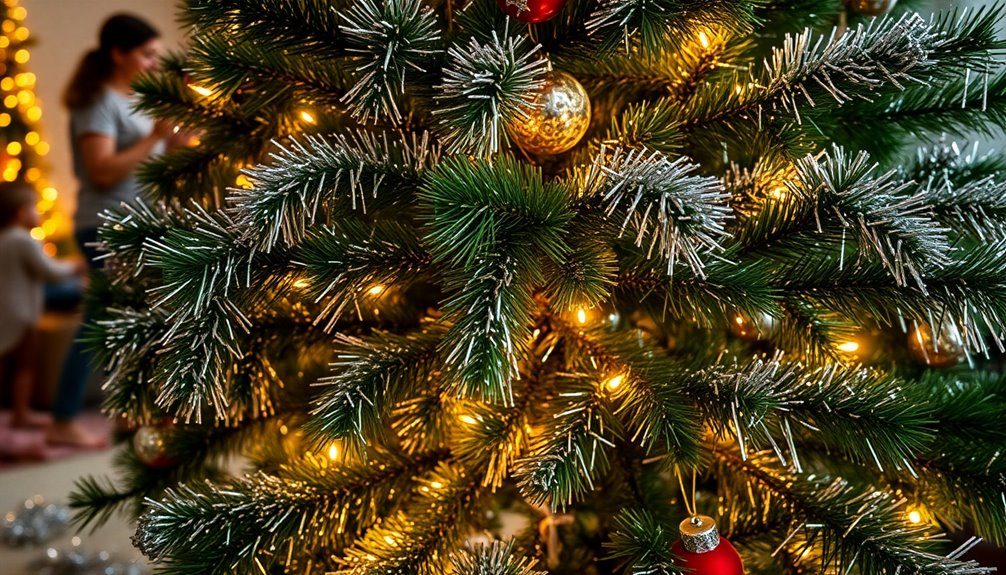
Tinsel's festive allure often overshadows its environmental consequences. Traditional tinsel, primarily made from non-biodegradable materials like PVC, greatly contributes to plastic pollution and poses recycling challenges.
This environmental impact has sparked a growing movement advocating for sustainable holiday practices. As you decorate, it's worth reconsidering your choices.
Eco-friendly alternatives, like biodegradable decorations made from natural materials, are becoming popular among environmentally conscious consumers. The concerns regarding the ecological footprint of plastic tinsel have led to increased efforts promoting sustainable options, such as dried fruits and nuts. Additionally, embracing eco-friendly practices can help minimize the overall impact of holiday decorations on the environment.
Modern Alternatives to Tinsel
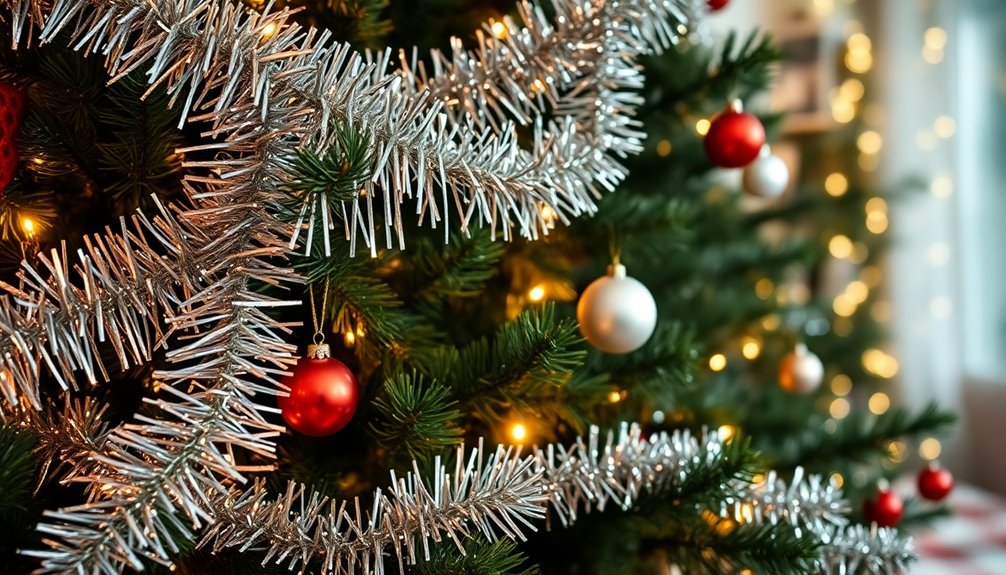
When you look for ways to decorate your home for the holidays without the environmental drawbacks of traditional tinsel, you'll find a wealth of modern alternatives.
Eco-friendly tinsel made from biodegradable materials is becoming a popular choice for those seeking sustainable holiday decoration options. Consider natural decorations like dried fruits, nuts, and handmade ornaments that add charm while being eco-conscious.
Innovations have led to tinsel-like decorations crafted from recycled paper or fabric, offering a fresh twist. You might also opt for garlands made from organic materials like pinecones, evoking a rustic aesthetic.
Plus, the rise of DIY projects encourages you to create your own tinsel substitutes using glittering ribbons or twine, promoting both creativity and resourcefulness in your festive decorating.
Frequently Asked Questions
What Does Tinsel on a Christmas Tree Represent?
Tinsel on a Christmas tree represents joy and celebration.
When you drape it across your tree, you're adding a touch of sparkle that enhances the festive atmosphere. The shimmering effect mimics ice, reflecting the warm glow of lights, creating a magical ambiance in your home.
This decorative element invites a sense of wonder, allowing you and your family to embrace the spirit of the season while enjoying a beautiful, glowing centerpiece.
Where Did the Tradition of Tinsel Come From?
You might be curious about where the tradition of tinsel came from. It dates back to the early 17th century in Germany, where it was first used on Christmas trees.
Originally made from real silver, it was designed to catch the light of candles.
Over the years, tinsel evolved, moving from expensive materials to more affordable options.
Today, it adds a festive sparkle to your holiday decorations, continuing a beautiful tradition.
What Is the Meaning Behind Tinsel?
Tinsel represents joy and celebration during the festive season. When you hang it on your tree, you're adding a sparkle that mirrors the twinkling of stars, creating a magical atmosphere.
It's not just decoration; it's a way to evoke nostalgia and warmth, enhancing your holiday experience.
Over the years, tinsel's evolution from luxury to accessibility reflects a broader appreciation for festive traditions, making it a beloved staple in your holiday decor.
What Is the Spiritual Meaning of Tinsel?
Tinsel's twinkling treasures truly transform your holiday experience! It symbolizes light, hope, and joy, reflecting the spiritual essence of the season.
As you hang it on your tree, remember it represents renewal and life, echoing the divine presence during festivities. The shimmering strands remind you to appreciate beauty and embrace the fleeting moments in life.
This festive adornment invites you to connect with traditions that uplift and inspire during the holidays.
Conclusion
As you hang shimmering strands of tinsel, remember the rich history woven into each sparkle. This tradition, once a symbol of wealth and opulence, now dances through your holidays, reflecting the glow of twinkling lights and laughter. Yet, as you admire the glinting beauty, consider the environment beneath the glimmer. Embrace modern alternatives that keep the spirit alive while protecting our planet, ensuring future generations can enjoy the enchanting magic of tinsel on their trees.
